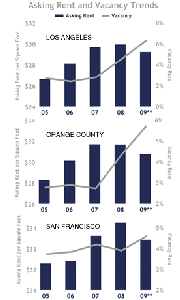Few Bright Spots in Key Retail Markets
Rising unemployment, a falling housing market and continuing falloff in consumer spending will push up retail vacancies and lower rents in 2009, according to real estate company Marcus & Millichap’s annual retail forecast.
In Los Angeles County, retail sales are projected to dip about 10 percent this year while vacancies will climb close to two percentage points to above 6 percent. Rents should drop about a dollar to $29.12.
Marcus & Millichap’s report singled out the San Fernando Valley as being among the hardest hit when it comes to retail vacancies because of the eroding housing market there. The report also pointed to key projects possibly sparking business: L.A. Live! in downtown Los Angeles and a new Bloomingdale’s and Nordstrom to open at the new Santa Monica Place in Santa Monica this fall.
The San Francisco market faces a similar situation, though its employment base is tied to financial markets, which is projected to contribute to a 2.3 percent drop in employment growth. However, retail hot spots such as Union Square and trendy community strips such as Chestnut and Fillmore streets are expected to keep retail numbers outperforming the U.S. average.
Vacancies are expected to jump 70 basis points to 4.6 percent, and rents are forecast to drop 2.5 percent to $33.38 per square foot. The report pointed out that opportunities may arise in the Mission District, Potrero Hill and SOMA because of a redevelopment plan being undertaken by the city.
In Orange County, retail vacancies are forecast to push up 140 basis points to 5.7 percent by the end of the year, yet the market is expected to be among the tightest in the country because of limited construction and the county’s embedded wealth. Rents are projected to drop 2.9 percent to $30.64.
Key growth engines include Disney’s California Adventure theme park in Anaheim, which is undergoing a $1 billion redevelopment aimed at attracting more tourism and bolstering retail sales in the region.
Falling trade means rising warehouse vacancies
The slowness on the global trade front is continuing to create a negative impact on industrial real estate in the Greater Los Angeles basin, which includes Los Angeles, Orange and Ventura counties and the Inland Empire.
Port activity was down more than 7 percent in 2008, resulting in the lowest levels in five years. Declining imports and a drop off in consumer spending, along with increased costs associated with the Clean Truck Program, all hurt real estate growth throughout the region.
Lease rates dropped 2 cents to $0.50 per square foot while average sale prices declined $1 to $117 per square foot during the fourth quarter of 2008, according to real estate company Colliers International. Vacancies hit 6.6 percent for the region, up from 5 percent.
Sales in central Los Angeles dropped 14.2 percent to $105 per square foot, the sixth straight quarter of sales declines. Limited access to credit is the main culprit for the decline. The deals that are getting done show that the buyers are putting down big down payments, as was the case when Jones Apparel recently bought a building in Montebello, just east of Los Angeles. The New York–based manufacturing giant paid 33 percent of the purchase price as the down payment.
Among the hardest hit areas is the Inland Empire, which is being plagued by the highest unemployment rates in the region, hitting 9.5 percent in November. That contributed to vacancies nearly tripling over the past year in the western part of the Inland Empire. In the eastern part of the Inland Empire, vacancies hit the 20 percent mark, rising from 14.5 percent at the beginning of the year.
In Orange County, where a number of surfwear companies are based, rental rates decreased $0.02 to $0.75 per square foot per month. Colliers researchers said the market is facing pressure from more central submarkets such as Vernon, which should push prices down further.
Colliers said businesses throughout the region are contracting and putting expansion plans on hold. Therefore, rental rates and sales prices will continue to decline.
(LINK: view larger charts from 1st page)
























